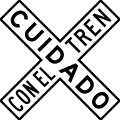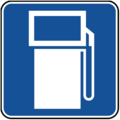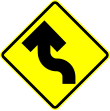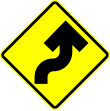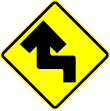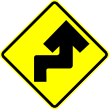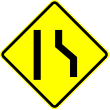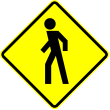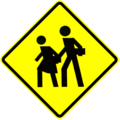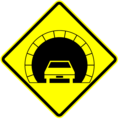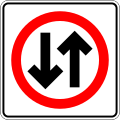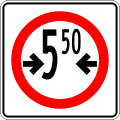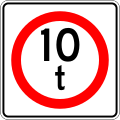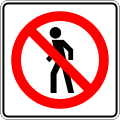Road signs in Mexico
From Wikipedia, the free encyclopedia
Road signs in Mexico are regulated by Secretaría de Infraestructura, Comunicaciones y Transportes's Directorate-General for Roads (Dirección General de Carreteras), and uniformized under a NOM standard and the Manual de Señalización y Dispositivos para el Control del Tránsito en Calles y Carreteras (Manual of Signage and Traffic Control Devices for Streets and Highways), which serves as a similar role to the MUTCD developed by the Federal Highway Administration in the United States. The signs share many similarities with those used in the United States and Canada. Like Canada but unlike the United States, Mexico has a heavier reliance on symbols than text legends.[1]
This article needs additional citations for verification. (September 2012) |

Before the eventual promulgation of an updated federal NOM standard in 2023, with a comprehensive catalog of signs for use in urban contexts—absent in previous norms[note 1]—signage varied across states[2][note 2]—for instance, the state of Jalisco applied its own sign standard to state highways that is based on the 2011 NOM standard, whose signs were largely identical to those designed for the 1986 Manual de Dispositivos. Among other things, mandatory signs are circular, as in the European and some South American countries but unlike in the federal NOM standard.[3] This updated standard also introduces a bespoke typeface for signs, called Tipografía México, which is based on the Mexico City "Calles" typeface, a design by Sergio Núñez[4] introduced in 2016.
This country drives to the right.
Vertical signage
This section needs to be updated. The reason given is: Signs here depict symbols from the 1986 standard; from 2023, all signs have updated symbology and typography from what is shown here. (November 2023) |
Regulatory signs
- SR-6: Stop
- SR-7: Yield
- SR-7B: Priority road
- SR-8: Customs
- SR-9: Speed limit
- SR-10: Right turn on red permitted
- SR-11A1: Go right
- SR-11A2: Go left
- SR-11A3: Go straight
- SR-11C: Keep right
- SR-12: Left turn only
- SR-12: Right turn only
- SR-13A2: Trucks keep right
- SR-14: Two-way traffic
- SR-15: Height limit
- SR-16: Width limit
- SR-17: Weight limit
- SR-18A2: Overtaking prohibited
- SR-19A1: Passenger vehicles prohibited from stopping
- SR-20: No stopping
- SR-21: Parking permitted
- SR-22: No parking
- SR-23: Left turn prohibited
- SR-23A: Right turn prohibited
- SR-24: U-turn permitted
- SR-25: U-turn prohibited
- SR-26: No entry
- SR-27: Pedal cycles, heavy vehicles and motorcycles prohibited
- SR-28: Animal-drawn vehicles prohibited
- SR-29: Agricultural vehicles prohibited
- SR-30: Pedal cycles prohibited
- SR-31: Pedestrians prohibited
- SR-32A5: Heavy vehicles prohibited
- SR-22A6: Motorcycles prohibited
- SR-33: Use of audible signals prohibited
- SR-34: Seat belt required
- SR-35: No switching to left lane
- SR-35A: No switching to right lane
- SR-36: Motor vehicles prohibited
- SR-37: One way
- SR-37A: Two way
Warning signs
- SP-6A: Curve (left)
- SP-6: Curve (right)
- SP-7A: Sharp curve (left)
- SP-7: Sharp curve (right)
- SP-8A: Reverse curve (left)
- SP-8: Reverse curve (right)
- SP-9A: Sharp reverse curve (left)
- SP-9: Sharp reverse curve (right)
- SP-10A: Winding road (left)
- SP-10: Winding road (right)
- SP-11: Crossroads
- SP-12: T-junction (left)
- SP-12a: T-junction (right)
- SP-14: Delta junction
- SP-14: Branch junction (left)
- SP-14a: Branch junction (right)
- SP-15: Y-junction (left)
- SP-15a: Y-junction (right)
- SP-16: Roundabout
- SP-17: Merging traffic
- SP-18: Two-way traffic
- SP-19: Exit ahead (right)
- SP-19a: Exit ahead (left)
- SP-20: Symmetrical road narrows
- SP-21: Asymmetrical road narrows
- SP-22: Drawbridge
- SP-23: Narrow bridge
- SP-24: Width limit
- SP-25: Height limit
- SP-26: Ford
- SP-27: Unpaved road ahead
- SP-28: Slippery road
- SP-29: Steep descent
- SP-30: Falling rocks
- SP-31: Stop sign ahead
- SP-31a: Yield sign ahead
- SP-32: Pedestrians
- SP-32a: Children
- SP-33: School zone
- SP-34: Domestic livestock
- SP-35: Railroad crossing
- SP-36: Tractors
- SP-37: Traffic signals ahead
- SP-38: Divided road begins
- SP-38a: Fork
- SP-38b: Divided road ends
- SP-39: Cyclists
- SP-40: Loose chippings
- SP-41: Bump ahead
- SP-41A: Rumble strip
- SP-42: Tunnel ahead
- SP-43: Dangerous crosswinds
- SP-45: Length limit
- SPP-1: Men working
- SPP-2: Pile of materials on the way
- SPP-3: Manual traffic control
- SPP-32: Temporary crosswalk
- SIP-8: Detour
Tourism and services
- SIS-1: Airport
- SIS-7: Litter container
- SIS-8: Parking zone
- SIS-10: Rail station
- SIS-11: Gas station
- SIS-13: Hotel
- SIS-17: Hospital
- SIS-19: Bus stop
- SIS-22: Restaurant
- SIS-51: Disabled accessible ramp
Guide signs
- Advance directional sign
Other
- SIR-1: Railroad crossing
Older signs
- SIS-7: Litter container
- SIS-10: Rail station
- SIS-11: Gas station
- SIS-13: Hotel
- SIS-19: Bus stop
- SP-6: Curve (left)
- SP-6: Curve (right)
- SP-7: Sharp curve (left)
- SP-7: Sharp curve (right)
- SP-8: Reverse curve (left)
- SP-8: Reverse curve (right)
- SP-9: Sharp reverse curve (left)
- SP-9: Sharp reverse curve (right)
- SP-10: Winding road (left)
- SP-10: Winding road (right)
- SP-16: Roundabout
- SP-10A: Exit ahead (left)
- SP-19: Exit ahead (right)
- SP-20: Symmetrical road narrows
- SP-21: Asymmetrical road narrows
- SP-30: Falling rocks
- SP-31: Stop sign ahead
- SP-31a: Yield sign ahead
- SP-32: Pedestrians
- SP-33: School crossing
- SP-33a: School zone
- SP-34: Domestic livestock
- SP-35: Railroad crossing
- SP-36: Tractors
- SP-37: Traffic signals ahead
- SP-38: Divided road begins
- SP-38a: Fork
- SP-38b: Divided road ends
- SP-39: Cyclists
- SP-40: Loose chippings
- SP-41: Bump ahead
- SP-42: Tunnel ahead
- SP-43: Dangerous crosswinds
- SPP-1: Men working
- SR-6: Stop
- SR-8: Customs
- SR-9: Speed limit
- SR-10: Right turn only
- SR-12: Left turn only
- SR-14: Two-way traffic
- SR-16: Width limit
- SR-17: Weight limit
- SR-18A2: Overtaking prohibited
- SR-19A1: Passenger vehicles prohibited from stopping
- SR-23: Right turn prohibited
- SR-24: Left turn prohibited
- SR-27: Pedal cycles, heavy vehicles and motorcycles prohibited
- SR-27A: Motorcycles prohibited
- SR-28: Animal-drawn vehicles prohibited
- SR-29: Agricultural vehicles prohibited
- SR-30: Pedal cycles prohibited
- SR-31: Pedestrians prohibited
- SR-32: Heavy vehicles prohibited
- SR-34: Seat belt required
- SR-37: One way
Notes
- Some new urban signage was introduced in advance of the 2023 NOM by SEDATU in its 2019 Manual de Calles.
- Compare the Jalisco and Mexico City signage manuals, for example.
References
Wikiwand - on
Seamless Wikipedia browsing. On steroids.












































































































